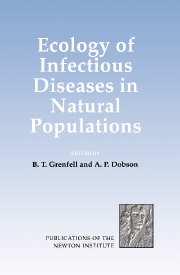Book contents
- Frontmatter
- Contents
- List of Participants
- Introduction
- BROAD PATTERNS AND PROCESSES
- PATHOGENS, INSECTS AND PLANTS
- Nonlinearities in the Dynamics of Indirectly-Transmitted Infections (or, does having a Vector make a Difference?)
- Model Frameworks for Plant-Pathogen Interactions
- The Dynamics of Insect-Pathogen Interactions
- IMPACT OF ECOLOGICAL AND GENETIC HETEROGENEITY
- Glossary
Nonlinearities in the Dynamics of Indirectly-Transmitted Infections (or, does having a Vector make a Difference?)
Published online by Cambridge University Press: 22 January 2010
- Frontmatter
- Contents
- List of Participants
- Introduction
- BROAD PATTERNS AND PROCESSES
- PATHOGENS, INSECTS AND PLANTS
- Nonlinearities in the Dynamics of Indirectly-Transmitted Infections (or, does having a Vector make a Difference?)
- Model Frameworks for Plant-Pathogen Interactions
- The Dynamics of Insect-Pathogen Interactions
- IMPACT OF ECOLOGICAL AND GENETIC HETEROGENEITY
- Glossary
Summary
Introduction
This paper approaches two general questions about the dynamics of indirectly-transmitted infections by looking in the first instance at infections transmitted by bloodsucking flies (diptera). The general questions are: How are the dynamics of indirectly-transmitted infections different from those of directlytransmitted infections? And how are the dynamics of vector-borne diseases distinct from those with other kinds of intermediate hosts? Both questions are to do with identifying non-linearities in the transmission process.
The obvious distinction between models for direct and indirect transmission is that the latter usually have at least one extra equation describing the dynamics of parasitism in the intermediate host. From a theoretical point of view, this paper is about the role this extra equation plays in the overall dynamics of insect-borne parasites. We look at the problem in two ways. The first is in terms of the different timescales upon which parasites, vectors, and vertebrate hosts operate. We bypass the more formal arguments which have been laid out by others (e.g. Nedelman 1984), and aim instead for visual impact. Our second theme explores less familiar ground—the part played by density-dependent processes in regulating the parasite population in its vector host.
A review of the available evidence leads to the proposition that, whilst various non-linear phenomena could in principle lend distinctive features to the dynamics of indirectly-transmitted pathogens, with one or two exceptions they generally do not do so for those transmitted by diptera. We offer an explanation in terms of the life history characteristics of intermediate hosts of this kind: they are relatively short-lived, and their mobility is crucial for transmission.
- Type
- Chapter
- Information
- Ecology of Infectious Diseases in Natural Populations , pp. 260 - 279Publisher: Cambridge University PressPrint publication year: 1995
- 18
- Cited by



